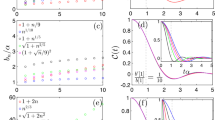Abstract
Fisher information is a cornerstone of both statistical inference and physical theory, leading to debate about whether its latter role is active or passive. Motivated by connections between Fisher information, entropy, and the quantum potential in the de Broglie–Bohm causal interpretation of quantum mechanics, the purpose of this article is to derive the position probability density when there a is a close and ubiquitous bonding of Fisher information and quantum potential. This is done by exploring a case in which a particle moves in a straight line and the integrands in Fisher information and expected quantum potential are proportional. It is found that in this case the probability density given by the Schrödinger wave equation has a Laplace distribution and that quantum potential is a negative constant at all points and times. It is noted that the rate of change of the entropy of the particle is bounded above by a limit that is proportional to the square roots of both Fisher information and the absolute value of quantum potential. Unlike Fisher information, quantum potential is a measure of a real physical potential, and it is proposed that it is quantum potential that puts an upper bound on the rate of change of the particle’s entropy and that, being negative in this case, may also act to contain the particle on its straight-line path. It is suggested that Fisher information does not have an active role in the physics, at least in this case, and only provides information about entropy.
Similar content being viewed by others
Change history
14 February 2021
An Erratum to this paper has been published https://doi.org/10.1140/epjp/s13360-021-01128-1
18 February 2021
An Erratum to this paper has been published: https://doi.org/10.1140/epjp/s13360-021-01128-1
Notes
If the equation includes the minus sign from Eq. (3.1) the solution is \(R=-\lambda {e}^{-\lambda |x-\theta |}\) and the results of the demonstration and the derivation of the pdf are unchanged.
References
P.R. Holland, The Quantum Theory of Motion: An Account of the de Broglie-Bohm Causal Interpretation of Quantum Mechanics, vol. Paperback (Cambridge University Press, Cambridge, 1997), p. 67
P.R. Holland, The Quantum Theory of Motion: an account of the de Broglie-Bohm causal interpretation of quantum mechanics, vol. Paperback (Cambridge University Press, Cambridge, 1997), pp. 68–70
P.R. Holland, The Quantum Theory of Motion: an account of the de Broglie-Bohm causal interpretation of quantum mechanics, vol. Paperback (Cambridge University Press, Cambridge, 1997), pp. 72–76
R. Carroll, On the Emergence Theme in Physics (World Scientific, Singapore, 2010), p. 1
B. Frieden, Roy Physics from Fisher Information A Unification (Cambridge University Press, Cambridge, 1999), pp. 22–29
B. Frieden, Physics from Fisher Information A Unification (Cambridge University Press, Cambridge, 1999), pp. 35–36
B. Frieden, Physics from Fisher Information A Unification (Cambridge University Press, Cambridge, 1999), pp.194–203
D. Bohm, B. Hiley, On the intuitive understanding of nonlocality as implied by quantum theory. Found. Phys. 5(1), 93–109 (1975)
D. Bohm, A suggested interpretation of the quantum theory in terms of hidden variables. Phys. Rev. 85(2), 180–193 (1952)
D. Bohm, B. Hiley, The Undivided Universe (Routledge, Milton Park, Abingdon, Oxfordshire, 1993).
Author information
Authors and Affiliations
Corresponding author
Appendices
Appendix
Solution of the differential Eq. (4.1a) and derivation of the pdf (4.2c)
The differential equation that must be satisfied to derive the amplitude of the wavefunction and hence the pdf when the integrand of the Fisher information is proportional to that of the quantum potential at each point x at each time t, expressed in shorthand notation where the variable is x, is \(( R^{\prime } )^{2} = {{RR}}^{\prime \prime }\), with support − ∞ ≤ x ≤ ∞ to allow the change of variable in Eq. (2.2).
The solution that needs to be demonstrated as such isFootnote 1
This solution yields.
From the solution, we get \(R^{2} = \lambda^{2} {\text{e}}^{{ - 2\lambda \left( {x - \theta } \right)}}\), \(x \ge \theta\,\,{\text{joined to}}\) \(\lambda^{2} {\text{e}}^{{ - 2\lambda \left( {\theta - x} \right)}}\), \(x < \theta\).
and the normalising constant is then
Normalising \(R^{2}\) and multiplying by \(\frac{2}{2}\) to put the pdf in the form of the Laplace distribution give:
From Eq. (2.4c), it can be seen by inspection that the Fisher information in each component of this pdf is \(4\lambda^{2}\), making a total of \(8\lambda^{2}\). Finally, from Eq. (1.1) and the above differential equation representing (4.1a), the quantum potential \(Q = - \frac{{\hbar^{2} }}{2m}\frac{{R^{\prime \prime } }}{R} = - \frac{{\hbar^{2} }}{2m}\frac{{\lambda^{3} }}{\lambda } = - \frac{{\hbar^{2} }}{2m}\lambda^{2}\) for each of the two components, so in total \(Q = - \frac{{\hbar^{2} }}{2m}2\lambda^{2}\) and quantum potential is constant at all points and times. As a result, the expected quantum potential E[Q] also equals \(- \frac{{\hbar^{2} }}{2m}2\lambda^{2}\) and \(I(t) = - \frac{8m}{{\hbar^{2} }}E\left[ Q \right]\).
Rights and permissions
About this article
Cite this article
Jenkins, T.C. An exploration of a special case in the relationship between Fisher information and quantum potential in the causal interpretation of quantum mechanics. Eur. Phys. J. Plus 136, 70 (2021). https://doi.org/10.1140/epjp/s13360-020-01050-y
Received:
Accepted:
Published:
DOI: https://doi.org/10.1140/epjp/s13360-020-01050-y



